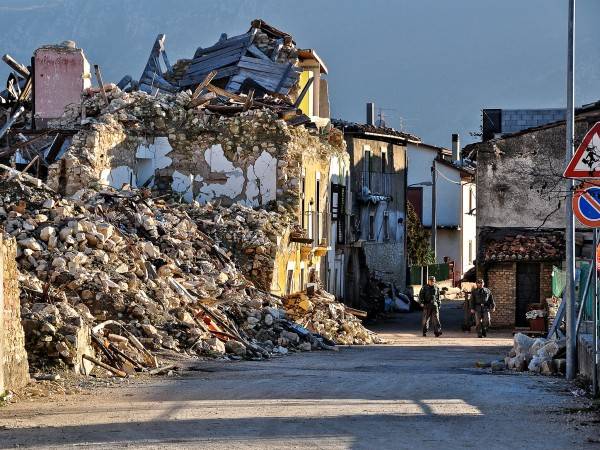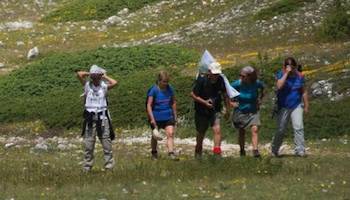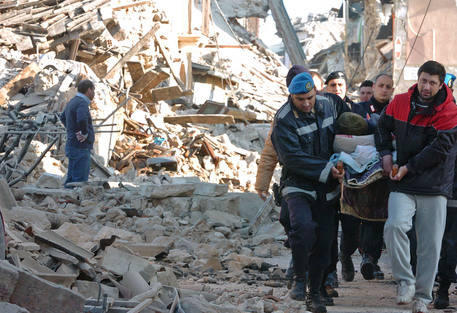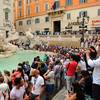L’Aquila Quake, Six Years Later
ROME – On April 6, for most Italians the Easter Monday national holiday of picnicking and country excursions, 10,000 braved the cold in L’Aquila to record the sixth anniversary of the earthquake that struck the beautiful medieval city in the Abruzzo, killing 309, leaving more than 50,000 homeless (some say over 70,000) and destroying or damaging tens of thousands of historic buildings. Church bells tolled as the torchlight procession led to the cathedral, where the names of all the victims were read.
This was not the only march of solidarity organized to commemorate that brutal 6.3
magnitude earthquake. Coming in early summer is a nine-day hike which begins June 27 in Rome and ends in L’Aquila nine days later.
The organizers of “Lunga Marcia per l’Aquila 2015” (the Long March for L’Aquila 2015) say that the goal of that trek, now in its fourth year, “is to build awareness of the reconstruction situation, and to familiarize both the participants and the communities through which they walk with the themes of anti-seismic prevention and knowledge of the territory.”
Reconstruction has been slow and controversial, to put it mildly. Premier Matteo Renzi Monday via Facebook that, “After too many promises, we are finally passing to action.” In his government’s 2015 budget $5.54 billion has been earmarked for medium- and long-term funding of projects there, he said.
A year ago, Renzi said, private construction projects amounting to $1.22 billion were approved “and are being accelerated” while another $86 million for rebuilding public facilities was “set aside.” Added Renzi, quoted in ANSA news service: “We have the money. We must spend it well as a duty in memory of those who died and out of respect for the survivors.”
This respect has been slow in coming. Resettlement in new housing for the seven hundred families left homeless by the quake of 2009 was the first reconstruction goal, as this reporter recalls from an early post-quake visit there. The homeless were, in fact, shuttled into thirteen brand new towns on the outskirts of the city. The new town construction costs have been estimated at a startling $2,900 a square meter, said to be triple the normal cost of construction. That construction, moreover, is reportedly inadequate: balconies were so shoddily built that some are unsafe, and in some cases families have been warned they must stay indoors or out on the street, but never on the balcony. Other complaints are of leaky roofs, open sewers and lack of maintenance of the towns.
Restoration of historic buildings meantime was placed on hold. By one estimate the 485 mostly historic buildings and sites requiring restoration will cost at least $600 million, and will not be completed unto 2021.
The casting of blame has been a giant problem. For months tremors had been felt, but a “Major Risks Commission” composed of seven scientists had met on March 31, only days before the quake struck, and announced that there was no serious risk. Their reassurances meant that at least 29 individuals did not leave their homes after feeling the first tremor. Hauled into court in 2012 on accusations of superficiality, all seven were convicted of manslaughter and sentenced to six years in prison.
But in February 2014 a three-judge court reversed their sentences, and six were acquitted while the seventh was given a reduced sentence, largely on technical questions such as the exact nature of the commission: was it a real commission or just a friendly meeting? And some argued too that the scientists’ reasoning – that a series of small tremors (a swarm, it is called) actually reduces the risk of a major quake – was accepted scientifically at that time, if less today after L’Aquila (!)
Last month the city’s Chief Prosecutor Romolo Como filed a formal appeal to the supreme Cassations court against these acquittals. The high court will address two issues: whether or not the commission was formally meeting so that its words were to be heeded, as the appeals court had decided; and if they ought to have shown more prudence even if it were not a regularly constituted “commission.”
General Prosecutor Como has also just filed a request to proceed against the then head of the Italian civilian protection agency, Guido Bertolaso, on charges that he failed to urge the proper precautions, such as to leave the house in case of a strong tremor. No decision has yet been made over whether the high court will deliberate on the suit against Bertolaso, however.
As for Renzi’s new reassurances, the respected journalist Gian Antonio Stella of the daily Corriere della Sera comments that the citizens of L’Aquila are reacting with “insults and sarcasm – they can’t quite forget that in more than a year the premier, in his whirlwind of trips abroad and important meetings (including to a Scout meeting at San Rossore), has not found the time to come to the city destroyed by the quake, to see for himself the historic city’s agony.”
The reassurances had begun with the then Premier Silvio Berlusconi, who predicted that everyone would be made happy in the near future. Subsequently Premier Mario Monti issued a 139-page decree of what was to be done. What all these promises amount to, says Stella, is merely a rickety bureaucratic box, “more anguishing than any building scaffolding.”









































i-Italy
Facebook
Google+
This work may not be reproduced, in whole or in part, without prior written permission.
Questo lavoro non può essere riprodotto, in tutto o in parte, senza permesso scritto.